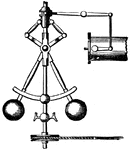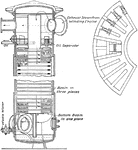
Interior View of Rateau Accumulator
"The accumulator may consist of a large tank in which are numerous plates over which water can flow,…

Aeolipile
"An instrument illustrating the expansive force of steam generated in a closed vessel, and escaping…
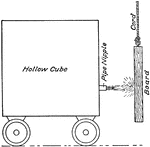
Apparatus for Measuring Jet Stream of Steam
"Suppose a hollow cube to be filled with some fluid (water or steam) at a given pressure, and to have…

Yorkshire Steam Wagon Transverse Boiler
A Yorkshire steam wagon transverse boiler. Water is continuously enters the large cylindrical container.…
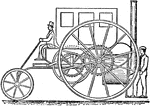
Side View of 1802 Trevithick Steam Carriage
The side view of 1802 Trevithick's Steam Carriage. This horseless carriage is operated by a steam engine…

Steam Engine Valve Centered with Piston
"It is usual to put the engine on center before setting the valve. First put the engine in a position…

Colonel Crompton's Superheated Steam Tractor
A superheated steam tractor built by Colonel Crompton. The boiler, located in the front, heats the water,…

Eccentric Motion of the Steam Engine Crank in Full Gear
"When set full gear forward, the valve admits steam to the crank end of the cylinder, and the crank…
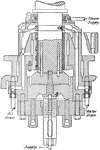
Cross Sectional View of Curtis Turbine Step Bearing
"The upper bearing with dowel—pins and key fit into corresponding dowel holes and key—way…

Mechanical Drawing of a Metal Cylinder
"Steam is admitted under pressure for a boiler into a metal cylinder behind a piston, as represented…
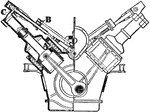
Bentley Eight Cylinder Diagonal Tandem Compound Superheated Steam Engine for Tractor
A eight cylinder Bentley superheated steam engine fitted to a tractor. The steam is used to move the…
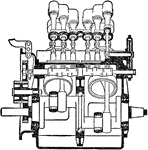
Sheppee Motor Company Compact Double Acting SUperheated Engine
"In this engine the cam—shaft by which the steam and exhaust valves are operated is situated midway…

Steam Engine with Reynolds Corliss Gear
"An eccentric on the main shaft gives an oscillating motion to a circular disc called the wrist plate,…
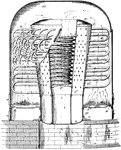
Steam Boiler Engine
This design with natural induction used for marine purposes was the popular “Scotch” marine boiler,…
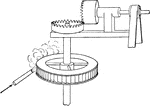
Steam Rotary Engine
An illustration of a rotary steam engine. The steam turbine system was invented by Branca in 1629. Steam…
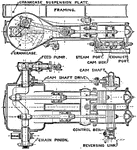
Twin Cylinder Steam Engine Fitted to Sentinel Wagons
Illustration showing a twin cylinder steam engine fitted to a sentinel wagon. The steam expands and…

Cross Sectional View of U.S.S Salem Steam Engine Showing Curtis Turbines
"The marine turbine of this type (Curtis turbine) installed in the U.S. Cruiser Salem had seven pressure…
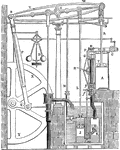
Watt's Double-Acting Condensing Steam-Engine
"Used a boiler to produce steam, chambers to condense it, and drive the pistons of the engine." —Quackenbos…
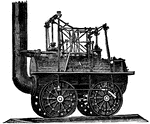
George Stephenson's First Locomotive
"George Stephenson is emphatically the engineer to whose intelligence and perseverance we owe the introduction…
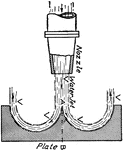
Force Measurement by Deflecting Water Jet 180 Degrees
"Now if the plate were shaped as shown, so that the direction of the jet were completely reversed turned…

Cross Sectional View of Four Stage Vertical Riedler Stumpf Turbine
A cross sectional view of a four stage vertical Riedler—Stumpf turbine. The steam enters and exit,…

Fowler's Anchor
"A massive square framework of wood, mounted on six sarp disc wheels, each about two feet in diameter,…

Fowler's Plough
"A framework of iron, balanced upon two large wheels. To each side of this framework there are attached…

Fowler's Steam-engine
"In 1854, Mr. Fowler exhibited his patent steam-draining apparatus at the Lincoln meeting of the Royal…
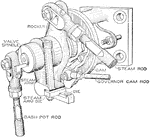
Steam Engine Brown Releasing Gear
"The governor cam rod operates a plate cam having a curved slot so shaped that it takes place of both…

Joy Steam Engine Valve Gear Rotating Wheel
A Joy valve gear for steam engine rotating the wheel in the direction of the arrow. The lever F changes…

Outline of a Steam Engine Marshall Gear Reducing Friction and Wear
An outline of the Marshall gear from a steam engine. The piston rotates the crank shaft at point H around…

Close up of Reynolds Corliss Gear from Steam Engine
"The steam arm is keyed to the valve spindle which passes loosely through a bracket on which the bell—crank…

Steam Engine with Walschaert Gear on Railroad
An illustration of the steam engine with Walschaert gear system on rail tracks. The piston moves the…
Close up View of Double Sliding Valve Gears from Steam Engine
"The main valve controls admission, release, and compression; the other (valve) regulates the cut—off…
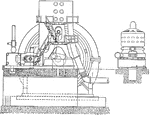
5000 kW Corliss and Curtis Steam Engine for Electric Generation
An illustration of a Corliss steam engine to generate 5000 kW of electricity. The turbines to create…

Corliss Steam Engine Generator Plan
"By placing the condensers underneath the turbine, as is frequently done at the present time, not only…

Cross Section View of Rateau Turbine Electric Generator by Western Electric Company
A cross sectional view of Rateau electric generator turbine by Western Electric Company. Steam is used…

De Laval Steam Turbine Connected to Generator
A De Laval steam turbine connected to a generator. The turbine generates electricity by turning the…

DeLaval Steam Electric Generator
"The bearings are of the plain ring—oiling type, usually provided with water jackets. The shaft…

Pearsons Turbine for Electricity Generator
A cross sectional view of the Pearsons turbine for generating electricity. The turbines, located in…

Westinghouse Turbo Steam Engine Generator Plan
"Turbines require very much smaller foundations than reciprocating engines reciprocating engines of…

Zoelly Condensing Turbine Electric Generator
"The Zoelly turbine has been developed rather extensively abroad, and is being manufactured largely…
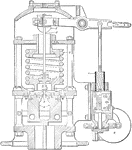
Sectional View of Governor for Varying Number of Nozzles Opened
"In the Curtis turbine, steam is admitted through a series of valves, the number of which depends upon…
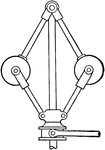
Governor with the Balls Connected to the Base for Steam Engine
A spindle governor where both balls are connected to the base. The governor is used to regulate the…
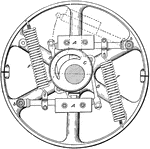
Buckeye Engine Governor
"A wheel which contains and supports the various parts of the governor is keyed to the shaft. Two arms,…
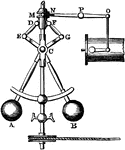
Electric Governor
"Governor of a Steam-engine. GOVERNOR. In machinery, a self-acting regulator which controls a supply…
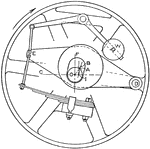
Top View of the Fly Wheel Governor Turning Clockwise
"All fly—wheel governors operate by shifting the eccentric either to change the angular advance,…
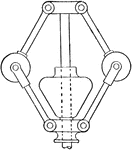
Spring Governor for Steam Engines
"This type of governor is used frequently on throttling engines; it consists of a pendulum governor…
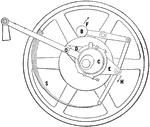
Straight Line Engine Governor
A straight line engine governor illustrating the direction of the ball (B) is going. The single ball…

Turbine Governor for Varying Time of Admission
"An admission of steam occurs about once in every thirty revolutions at approximately full load. The…
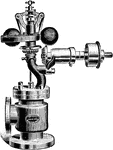
Waters Spring Governor with Safety Stop
"In this goveror the weights are always in the same plane, the variation in height being due to the…

Exterior View of Waters Spring Governor
An exterior view of a waters spring governor. The governor is used to regulate fuel by closing and opening…

Grasshopper-Beam
"Grasshopper-beam. a, rocking pillar; b, radius-bar of the parallel motion which secures verticality…
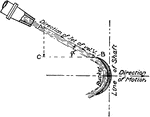
Jet Steam Stream Hitting Curved Vane
"If a jet with the velocity V strikes the bucket at an angle a, its velocity A B could be resolved into…

Steam Engine Gooch Link and Valve Gear Arrangement
"As the speed increases, and the link is 'notched up', the lead is increased as the cut—off is…
American Locomotive
"Three locomotives were imported from England in 1829, and the first trial in America took place Aug.…

Early Locomotive
"Three locomotives were imported from England in 1829, and the first trial in America took place Aug.…

Log and Reel
"Log is an apparatus for ascertaining the rate of a ship's motion. In a steam engine, a tabulated summary…
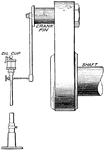
Belt Drive Oiling Apparatus
An apparatus used to oil the crank pin of the belt drive system. The oil cup is filled with lubricant…

Cross Sectional View of Parsons Turbine
"Steam enters at E and gradually expands in volume until it exhausts at G. The rotor is usually built…

